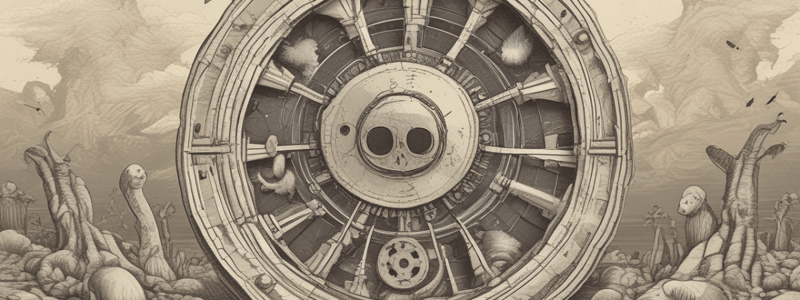Podcast
Questions and Answers
What is the process used to determine the age of a fossil by measuring the amount of radioactive element present?
What is the process used to determine the age of a fossil by measuring the amount of radioactive element present?
Absolute dating
Which elements are commonly used for absolute dating of fossils and their respective age ranges?
Which elements are commonly used for absolute dating of fossils and their respective age ranges?
Carbon/Nitrogen (100-50,000 years), Potassium/Argon (100,000-4.5 billion years), Uranium/Lead (10 million-4.5 billion years)
What information can scientists obtain from the fossil record?
What information can scientists obtain from the fossil record?
Scientists can show how organisms have changed, which organisms lived during the same time period, and which organisms share a common ancestor.
Why are some organisms not found in the fossil record?
Why are some organisms not found in the fossil record?
What is the significance of the number of holes behind the eye in fossils for understanding their evolution?
What is the significance of the number of holes behind the eye in fossils for understanding their evolution?
What term describes the process of determining the actual age of an event or fossil in years?
What term describes the process of determining the actual age of an event or fossil in years?
Which type of fossil is formed when the hard parts of an organism dissolve, leaving behind an empty space?
Which type of fossil is formed when the hard parts of an organism dissolve, leaving behind an empty space?
How do scientists determine the age of a fossil without using actual dates?
How do scientists determine the age of a fossil without using actual dates?
Which type of fossil shows the activity of ancient organisms?
Which type of fossil shows the activity of ancient organisms?
How does the fossil record support the theory of evolution?
How does the fossil record support the theory of evolution?
Flashcards
Absolute Dating
Absolute Dating
Determining fossil age by measuring radioactive elements.
Elements for Absolute Dating
Elements for Absolute Dating
C/N (100-50k yrs), K/Ar (100k-4.5b yrs), U/Pb (10m-4.5b yrs)
Fossil Record Insights
Fossil Record Insights
Changes, co-existence, and ancestry.
Missing Organisms in Fossil Record
Missing Organisms in Fossil Record
Signup and view all the flashcards
Holes Behind Eye Significance
Holes Behind Eye Significance
Signup and view all the flashcards
Absolute Dating
Absolute Dating
Signup and view all the flashcards
Mold Fossil
Mold Fossil
Signup and view all the flashcards
Relative Dating
Relative Dating
Signup and view all the flashcards
Trace Fossil
Trace Fossil
Signup and view all the flashcards
Fossil Record supports Evolution
Fossil Record supports Evolution
Signup and view all the flashcards
Study Notes
Fossil Record and Evolution
- A fossil is the preserved remains or evidence of an organism, used to document changes in organisms over time and identify extinct species.
Fossil Formation
- When an organism dies, its remains fall to the bottom of an ocean or lake, and layers of sediment cover it.
- Over time, the organism's remains are replaced with minerals, eventually becoming rock, forming a type of fossil called a cast fossil.
- Other types of fossils include mold fossils, where the hard parts of an organism dissolve, leaving an empty space, and trace fossils, which show the activity of ancient organisms.
Determining the Age of a Fossil
- Scientists use radioactive elements to determine the age of a fossil, measuring the amount of radioactive element and stable element in a rock.
- Different elements are used for absolute dating, including carbon, potassium, uranium, and lead, each with its own range of years.
The Fossil Record and Geologic Time Scale
- The fossil record provides information on the history of life on Earth, showing how organisms have changed over time.
- By knowing the age and location of a fossil, scientists can show which organisms lived during the same time period and which have a common ancestor.
Fossil Evidence for Evolution
- The fossil record shows evidence of how reptiles have changed over time, with fossils showing different numbers of holes behind the eye.
- Fossils of sponges, fish, amphibians, reptiles, and mammals provide evidence of a long history of changing life forms.
Key Concepts
- Radioactive elements release energy as they break down into stable elements.
- Absolute dating determines the actual age of an event or fossil in years.
- Relative dating puts events or fossils in order from oldest to youngest without using actual dates.
Studying That Suits You
Use AI to generate personalized quizzes and flashcards to suit your learning preferences.




